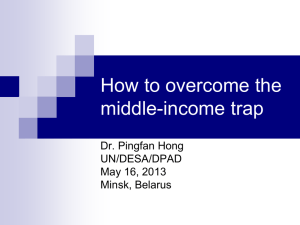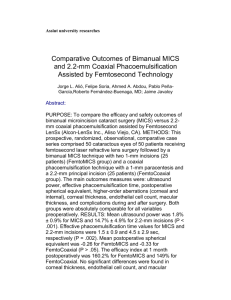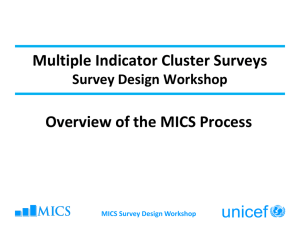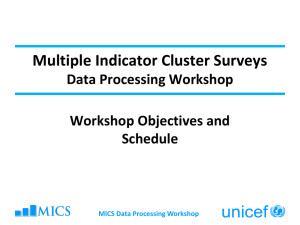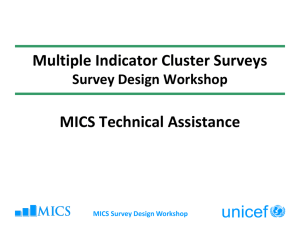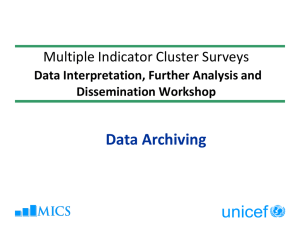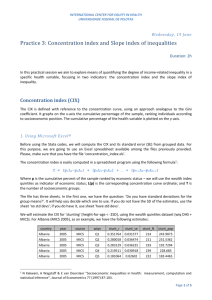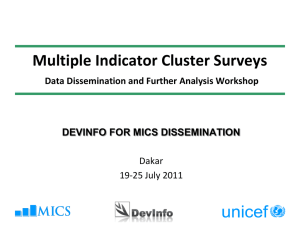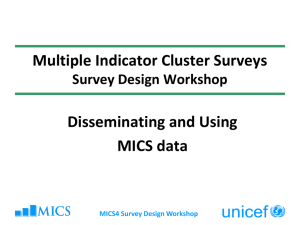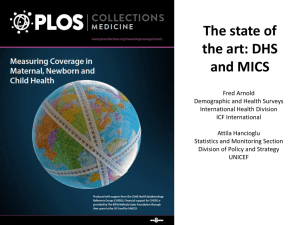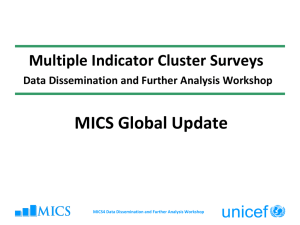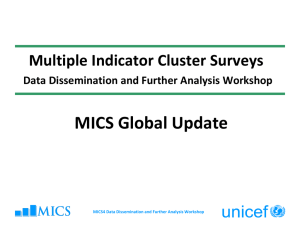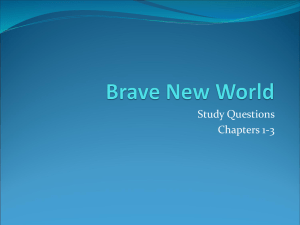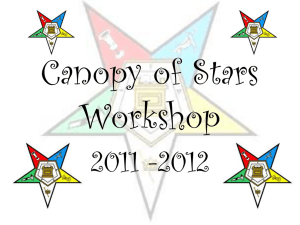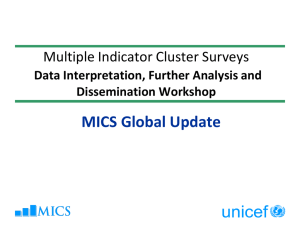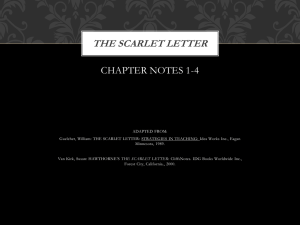Key Findings and Final Reports
advertisement
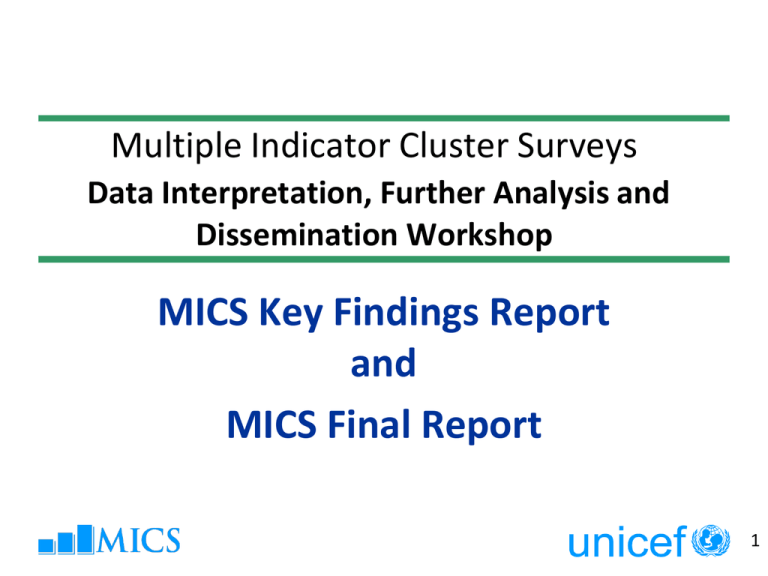
Multiple Indicator Cluster Surveys Data Interpretation, Further Analysis and Dissemination Workshop MICS Key Findings Report and MICS Final Report 1 Session Objectives To gain knowledge on using the MICS report templates and tabulation To gain tips and advice on what needs to be paid attention to in order to use these templates to produce good quality high level reports 2 The MICS Report Templates There are two templates available in MICS which can be customized by countries depending on the content of the survey: 1. Key Findings Report 2. Final Report Templates are/will be available in: English French Arabic Russian Spanish 3 Why use the MICS templates? To facilitate the efficient production of MICS reports so countries do not have to “reinvent the wheel” and spend time on the design of tables, indicator explanations etc. To ensure the production of comparable reports that can be used easily to draw comparisons between countries To increase confidence among users in the survey; MICS is a recognised household survey programme with an internationally accepted methodology 4 The Global MICS Report Review Process Step Action Step 1 Datasets and tables are technically reviewed by Global MICS Team Step 2 Based on templates, first draft of report(s) generated at the country level (and here) Step 3 Draft report are technically reviewed by Regional office and Global MICS Team Finalization of reports at country level Step 4 5 The Key Findings Report 6 Why produce a Key Findings Report? To disseminate all national level results on all indicators to stimulate interest in the survey To provide quick results to bide time while working on the final report To release the most critical results, such as on mortality and malnutrition, to allow for possible programme response as soon as possible 7 What is in the Key Findings Report? A data-oriented and visual report that needs no text/writing or substantial work on customising the tabulation plan. The tables contain all national level results on all MICS indicators. The graphs present key indicators and provide critical disaggregation, not available in tables. 8 Drafting the Key Findings Report An expected output of this workshop is your Key Findings Report. Each group work session must include time for you to customise the template. The first of such sessions immediately follows to introduce you in detail to the work ahead. 9 Drafting the Key Findings Report 10 Drafting the Key Findings Report 11 Drafting the Key Findings Report 12 The Final Report 13 What is the Final Report objective? To convey the results of the survey to a wide audience which includes government agencies, non-governmental organizations, other multilateral donors, the press, and the general public 14 What is in the final report? Describes the current situation of children and women taken from all indicator results included in the survey Includes detailed information on survey methodology and implementation to allow readers to fully understand the methodology and tools used and how the findings are produced. 15 Who should write the Final Report? Typically the MICS implementing agency and/or members of a stakeholder/technical committee write the report. Chapters can be divided among different people. It is useful to have people familiar with subject matter. Experts in various fields should be consulted and asked to review the tables in order that the key messages and any unusual findings are addressed and dealt with properly in the report and that technical terminology is appropriately used. 16 Content of the Final Report Template Executive Summary Front Matter (contents, summary table, foreword, etc.) Introduction Sample and Survey Methodology Results Chapters (presented by theme) Sample Design Personnel Involved Appendices Estimates of Sampling Errors Data Quality Tables Indicator List Questionnaires 17 Final Report Templates www.childinfo.org 18 Final Report Examples MICS4 surveys from www.childinfo.org 19 Summary Table of Characteristics and Findings 20 The Executive Summary Readers usually only have time or interest to read the executive summary, yet typically this part of the report is very weak The executive summary needs to highlight the key findings of the survey and present information to a potentially non-technical audience of decision and policy makers 21 The Executive Summary Poorly written executive summaries are usually a collection of bullet points that are simply a copy and paste of sentences in the main report, regardless of how important those findings are Strong executive summaries are those that give a brief description of the survey and go on to provide a short narrative for each theme highlighting indicator results at the national level and then providing the most severe disparities 22 Introduction A brief chapter providing background and objectives of the survey. 23 Sample and Survey Methodology A well written and comprehensive description of the sample design and methodology will lend credibility to the results even if it raises some possible limitations Anyone reading the sample design, even if they have little knowledge of sampling issues, should be able to understand what was done at each stage of the design to select households 24 Sample and Survey Methodology Should not remain generic and only based on the template. Issues that arose in fieldwork or issues that may have caused some bias in the final results should be raised. Relevant MICS indicators that have been excluded, perhaps due to inclusion in other recent surveys, should be mentioned and other sources referenced. 25 Sample and Survey Methodology Country specific additions to questionnaires should be included as non-MICS additions. If a survey has not followed MICS standard protocols and guidelines fully then it is expected that this will be documented in the final report in detail. 26 The Results Chapters - Tables Tables are within the results chapters and not at the end of the report Do not import all tables into the final report until they have been checked and verified through the global MICS program. From countless experiences, lots of unnecessary double work can be saved! Export the data from SPSS to the excel tabulation plan first to check the tables format before exporting to the word document 27 The Results Chapters - Tables All tables should be run weighted and un-weighted. The size of the un-weighted denominators should be checked for each table Results based on denominators of 25-49 unweighted cases should be put in parentheses, e.g. (43.2) Results based on denominators of less than 25 unweighted cases should be denoted by an asterisk in parentheses: (*) 28 The Results Chapters - Table Conventions Background variables can be recoded into fewer categories if necessary e.g. wealth quintiles – Richest 40%, Poorest 60% Categories of background variables with very few cases i.e. less than 25 can be omitted from the table with a footnote provided to explain this e.g. 3 unweighted cases with missing mother’s education not shown All indicator numbers (both MICS and MDG indicators) should be provided as table notes 29 30 31 The Results Chapters - Narrative Text First, consult other sources of data as much as possible to make sense of results, but do not present the other sources Next, report the value of each indicator. Point out subgroups or regions that may be lagging behind others Describe patterns across age, education and socio-economic groups, particularly if these patterns are consistent and substantial 32 The Results Chapters - Narrative Text It is not recommended to use the report to perform and present trend analysis, but keep comparisons with other surveys in mind. Wherever possible, support findings from data with policy interventions – but only to the extent of a couple of sentences. Acknowledge puzzling or inconsistent results. Indicate if there is an unexpected finding which was also observed in another survey 33 The Results Chapters - Narrative Text It is not necessary to take every table and comment on them one at a time, use a narrative keep all results of that section from all tables, or from other topics in mind Need to be careful with using background variables to describe data i.e. ethnicity is always of household head which should be borne in mind when describing women and child tables. Wealth index is of the whole household etc. 34 The Results Chapters - Narrative Text Always use the right and the same terminology for the variables and their categories names (e.g. Wealth Index: The richest and not the richer) The template provides suggestions for describing findings in the table but can only ever be used as a guide as sentences in the template may not match the country specific data. 35 The Results Chapters - Narrative Text When possible, sampling error tables should be used in order to make sure that differences being emphasised in the text from the tables are not within sampling errors. If need be, emphasise instead that results are within sampling errors – in text or in graphs – by using the calculated confidence interval. 36 The Results Chapters - Narrative Text Transparency is vital! Don’t cover up any irregular or surprising findings. These should be mentioned even if explanations cannot be given a clause for further analysis and investigation should be included. Do not invent explanations! If for any reason tables/indicators are not included in the main report, but the questions did appear in the questionnaire, then the reason for their exclusion needs to be stated in the report. 37 Example of an inaccurate use of template Template: About one in five young women age 15-19 years is currently married (%% per cent). This proportion does not vary much between urban (%% per cent) and rural (%% per cent), but is strongly related to the level of education. Example from a Final Report: About one in five young women age 15-19 years is currently married. This proportion does not vary much between urban (27 per cent) and rural (31 per cent), but is strongly related to the level of education. 38 Further tips! It is usually good practice that a single committed individual is coordinating the report writing: It improves harmonisation of text and adherence to deadlines, as well as providing a clear link between table production and text production. Use people who want to write (and can write). If you can, avoid people who must write. 39 Further tips! Keep a list of issues as they appear. This will help keeping track and serve as a memory bank of the many topics for further analysis that always are inspired by report writing. Try to finalise the chapters one by one. Report writing is straight-forward, but is also known to become delayed. By keeping a structured approach, the process towards a final report flows easier. 40 Further tips! To increase the quality of the report it is worth considering employing a editor/proof reader. This will also minimise the time spent in reviews by all parties. 41 Further tips! An important detail: Copying straight from SPSS Output (Crtl-C) to Excel can give problems between some versions (e.g. does not copy over table notes). Use the automated syntax to export to Excel and use the customized tabplan! And finally: Follow the Technical Assistance Framework of MICS. Take advantage of UNICEF’s Regional Office. 42 Step 21: Report Writing RO mobilises regional household survey expert to provide support in country as needed. Due to MDG deadline, additional TA is provided to countries anticipated to not complete the report in 12 months after data collection Draft of final main report produced Draft shared with RO for review (Feedback provided within 2 weeks) Draft shared with RO for Global MICS Team HQ consolidated review and feedback (within 2 weeks) Main Report finalised 43 Step 22: Printing Print ready version sent to RO for final feedback (within 7 days) Report Printed (Hard copies sent to RO and HQ) pdf version shared with RO for Global dissemination at childinfo.org 44 Group Work Teams will work in groups to start editing and customizing the Key Findings Report template by inserting survey specific information and deleting those that are not applicable Your facilitator will introduce you to the tools and guide you on the first work of customisation You will continue this work throughout the week 45
